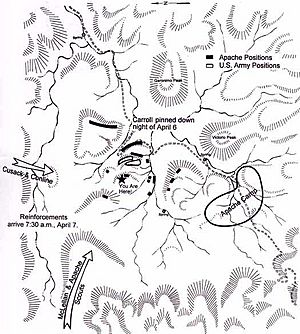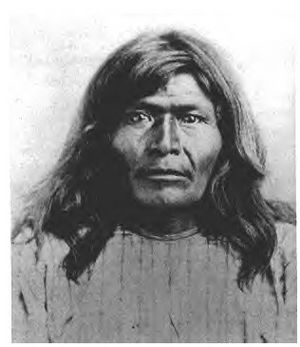Battle of Hembrillo Basin facts for kids
Quick facts for kids Battle of Hembrillo Basin |
|||||||
|---|---|---|---|---|---|---|---|
| Part of the Apache Wars, Victorio's War | |||||||
 A map of the engagement in Hembrillo Basin. Note that N is to the left on this map. |
|||||||
|
|||||||
| Belligerents | |||||||
| Apache | |||||||
| Commanders and leaders | |||||||
| Victorio | |||||||
| Strength | |||||||
| c. 220 cavalry, 150 Indian scouts | ~150 warriors | ||||||
| Casualties and losses | |||||||
| 2 killed 5 wounded |
perhaps 3 dead | ||||||
The Battle of Hembrillo Basin happened from April 5 to 8, 1880. It was a fight between the United States Army and a group of Chiricahua and Mescalero Apaches. These Apache warriors were led by their chief, Victorio. This battle was the biggest one during Victorio's War, even though not many people were hurt on either side.
Victorio and his warriors successfully defended their position. They held off a larger group of American soldiers and Indian scouts. They also managed to get their women and children to safety and then left the area without being caught. Today, Hembrillo Basin is part of the White Sands Missile Range, so you can't visit it easily.
After this battle, Victorio was forced out of his strongholds. He then fought a series of battles against thousands of American and Mexican troops. He was eventually defeated and died a few months later.
Contents
Why the Battle Happened
Victorio was a skilled warrior and a chief of the Mimbres Chiricahua Apache. He and his people were being forced to move to the San Carlos Apache Indian Reservation in Arizona. Because of this, Victorio left the Mescalero Reservation in New Mexico on August 21, 1879. He took about 80 warriors, along with their families. Soon, more Apache people joined his group.
The U.S. Army chased Victorio and his followers. They fought several small battles, but Victorio always managed to escape. He and his group moved across southern New Mexico and into western Texas and Mexico.
In March 1880, Pueblo Indian scouts found Victorio hiding in Hembrillo Basin. This area is on the western side of the San Andres Mountains. The army commander, Colonel Edward Hatch, decided to attack. He split his forces into four groups to try and surround Victorio.
- Major Morrow's group (about 100 soldiers and some Indian scouts) would attack from the north.
- Captain McClellan's group (85 soldiers and 40 Indian scouts led by Lt. Charles B. Gatewood) would attack from the south.
- Captain Carroll's group (over 100 men from the 9th Cavalry, known as Buffalo Soldiers) would come from the west.
- Captain Hooker's group (over 100 soldiers and some Navajo scouts) would wait on the eastern side of the mountains to block any escape.
The attack was planned for April 8. The goal was to trap Victorio.
However, the plan quickly went wrong. Major Morrow's group was delayed because they couldn't find water. They never reached the battlefield. Captain Carroll and his Buffalo Soldiers didn't know about Morrow's problem. They advanced up the Hembrillo Valley on April 5. Carroll sent 29 soldiers and two Indian guides ahead to scout. These scouts found fresh trails left by horses and cattle.
The Battle Begins
On April 5, around 5:30 PM, Lieutenant John Conlin and his scouts saw 35 to 50 Apaches moving towards them. Conlin quickly set up a defensive line, and a gunfight started. Two soldiers were wounded. The Apache stopped fighting when night came, and Conlin's group went back to Captain Carroll's main force. One of Conlin's scouts recognized Victorio himself leading the Apache attack.
Captain Carroll was worried that the Apache might escape. So, on April 6, he decided to advance on them. He first split his soldiers, sending two companies along Conlin's route. He led two other companies of 71 men on a different route from the northwest, hoping to surprise the Apache. But then he changed his mind and ordered his forces to reunite. He continued his advance anyway.
Late that afternoon, Carroll entered Hembrillo Basin with his two companies. The other two companies were following behind. Carroll spread his soldiers out in a V-shape and moved forward. But the Apache were on higher ground and started shooting from far away. Carroll managed to capture a small ridge. However, he found himself surrounded by the Apache. He was also cut off from a nearby spring, which was the only water source. The Apache stopped fighting at nightfall, and Carroll's men settled in for a difficult night without water.
Apache Victory
Carroll's soldiers had a very uncomfortable night without water. The next morning, April 7, the Apache began to close in on them. Luckily, more army soldiers and Indian scouts arrived. The two companies that had been behind Carroll's group entered the basin that morning. Also, Captain McClellan arrived with his 85 American soldiers, including another company of Buffalo Soldiers. He also had 40 Indian scouts and 100 White Mountain Apache warriors, who were enemies of Victorio's Chiricahua.
The soldiers moved towards the Apache positions. Meanwhile, Lieutenant Gatewood led the Apache scouts in an attack on the Apache camp, where the women and children were. Victorio now faced almost 400 soldiers and Indian scouts. He began to pull his forces back. He moved his warriors who were surrounding Carroll to a high ridge south of the battlefield. They held off the army for a few hours. This gave the Apache women and children time to escape the area.
Victorio then pulled his men back in stages. A small group of warriors stayed behind to guard their retreat. They remained watchful until the next morning, April 8. After a brief fight, this rear guard also retreated.
Since most of the fighting happened from a distance, there were not many injuries on either side. Two Buffalo Soldiers were killed, and five more soldiers were wounded, including Captain Carroll. Scouts reported finding three Apache bodies. No Indian scouts were reported hurt. The Battle of Hembrillo Basin was the largest battle of Victorio's War in terms of the number of people involved.
Most of the U.S. forces in this battle were either African-American Buffalo Soldiers or Apache scouts. Some early reports by white officers suggested the Buffalo Soldiers got sick or accidentally stumbled into the fight. However, the 9th Cavalry of Buffalo Soldiers actually found Victorio's camp. Even though they were outnumbered, they bravely fought him until other units, also mostly Buffalo Soldiers and Indian scouts, could arrive.
What Happened Next
After the Battle of Hembrillo Basin, Victorio and his followers moved west. They were not seen again until April 28. On that day, his warriors killed up to 41 civilians in what became known as the Alma Massacre. Then, on May 14, he attacked Fort Tularosa, which is about 200 kilometers (124 miles) northwest of Hembrillo Basin.
The army believed that some Mescalero Apaches living on their reservation, about 70 kilometers (43 miles) from the battlefield, were helping Victorio with supplies and men. After Victorio escaped from Hembrillo Basin, Colonel Hatch ordered all U.S. forces in the area to go to the Mescalero reservation near Fort Stanton. A few days after the battle, 1,000 soldiers arrived there. The 400 Mescaleros, including 65 men, who lived on the reservation scattered. They were afraid they would be forced off their lands.
On April 16, Hatch began capturing the Mescaleros. He also took all their weapons and horses. Fourteen Mescalero men were killed during this roundup. The captured Mescaleros were held for about four months. Some managed to escape to Mexico or joined Victorio.
Learning from the Past
In 1988, archaeologists studied the Hembrillo Basin battleground. They found rock art and other old items. These findings showed that Hembrillo Basin, with its rare springs of drinking water, had been a special place for Native Americans for a long time.
The archaeologists also learned more about the battle, especially Victorio's fighting methods. Over 10 years, they found and mapped more than 800 bullet casings using GPS. By studying these casings, they found that they came from 147 different rifles and carbines, and 39 different pistols. The locations of the casings showed how well Victorio controlled his warriors.
Warriors with shorter-range rifles were placed near the spring to stop the army from getting water. Warriors with longer-range rifles were on top of ridges. They shot down at the American troops, keeping them about 600 yards (549 meters) away. Victorio's Apache warriors were very good at fighting defensively with a mountain behind them. When Victorio pulled his men back, he moved them from one ridgetop to another. This allowed them to keep holding off the attackers.
Officers from nearby White Sands Missile Range and Fort Bliss often visit the battlefield. They learn about how small groups can fight against much larger forces. Even today, items like rifle cartridges from the battle are still found there.




